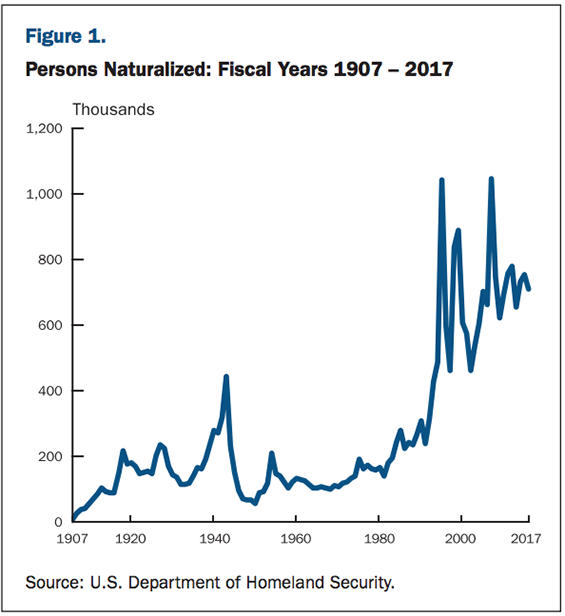
How to Fundamentally Transform a Country
Written by Daniel Horowitz
All things in life, even good things, have a limit to their utility and a point at which they become liabilities. Think of tasty spices in a dish or other ingredients in a melting pot. Quantities count, particularly over a specific period of time. Immigration is no different.
Recent Census data released from the 2017 American Community Survey (ACS) shows that immigration has grown to shocking, wholly unprecedented levels. Is it too much to ask that we engage in a mature policy discussion after five decades of record immigration with no end in sight?
The topline number from the survey shows that we have record 44.5 million immigrants in this country, composing 13.7 percent of the population – a greater share than at any time since 1910 and almost three times greater than the share of immigrants in 1970. 1910 was at the peak of the Great Wave, when we were a relatively young country, most of the immigration was from relatively similar backgrounds, there was no welfare state, there was a strong culture of assimilation, and most importantly, there was a subsequent shutoff.
Here are some other key nuggets from the survey:
- Together with the 17.1 million U.S.-born minor children of immigrants, immigrant families make up 20 percent of the population.
- A number of the countries with the sharpest increase in immigration since 2010 are Islamic countries and almost exclusively from the third world. Here is the breakdown from the Center for Immigration Studies: “Nepal (up 120%), Burma (up 95%), Venezuela (up 91%), Afghanistan (up 84%), Saudi Arabia (up 83%), Syria (up 75%), Bangladesh (up 62%), Nigeria (up 57%), Kenya (up 56%), India (up 47%), Iraq (up 45%), Ethiopia (up 44%), Egypt (up 34%), Brazil (up 33%), Dominican Republic and Ghana (up 32%), China (up 31%), Pakistan (up 31%), and Somalia (up 29%).”
- The two states with the largest increase in immigration since 2010 are Florida and Texas. They topped even the blue states of California, New York, and New Jersey. If you want to paint the electoral map blue, this is the surest way to do it.
Why this wave of immigration dwarfs the Great Wave
Aside from percentages, raw numbers do matter in our ability to assimilate. Over the 29-year period from 1989 to 2017, the U.S. has admitted 29.7 million immigrants. During a comparable 29-year period at the height of the Great Wave, from 1896 to 1924, only 17.9 million green cards were issued.
Also, because of shorter life expectancy and other factors, the Great Wave of immigration didn’t result in nearly as many naturalizations and a new voting population like this one has. This chart from the DHS is worth 1,000 words:
From 1996 through 2017, 15,453,174 new immigrants became citizens. During the Great Wave, the number of naturalizations was very low because it took time for immigrants to go through the system and become citizens. But even if you take an equivalent 22-year period with the highest level of naturalizations, which was from 1924 to1945, just 4,334,798 immigrants were naturalized. In other words, while the immigration wave of the modern era was almost twice as large as the Great Wave, the “naturalization wave” was three and a half times greater.
Moreover, we have not even reached the full extent of the wave of immigration, which is still growing. That means the naturalization boon to the Democrat Party will only continue to grow as we finish the lag time for existing immigrants to become citizens.
Numerous factors distinguish the Great Wave favorably from this wave; they are the subject of chapter 7 in my book. But the most important of all is that there was a shutoff for several decades thereafter. This point was so obvious to anyone living at the time that when Congress decided to shut off immigration on February 22, 1921 (temporarily, until the long-term bill was developed in 1924), the bill passed the U.S. Senate 78-1 and passed the U.S. House without a recorded vote! Expressing the universal view at the time, the accompanying report from the U.S. House Committee on Immigration and Naturalization stated, “There is a limit to our power of assimilation.”
It was obvious at the time that a cool-off was in order, and history, along with the success of assimilating the Great Wave immigrants, proved it right. And while people at the time expressed concerns about the lack of assimilation, nobody back then had reason to fear a lack of assimilation turning into the disaster it is in Europe today as a result of the large migration from the Middle East, a policy we have now mimicked.
Rather than a shutoff, we are accelerating mass migration with no questions asked
One could argue that by the early 1990s, we had already surpassed the size, scope, and cultural transformation of the equivalent period of the first Great Wave. At the time, even liberals like Harry Reid warned that we had never seen anything like this before and introduced a bill to “restore immigration to its traditional and more manageable level of about 300,000 annually.”
Fast-forward 25 years, and we’ve admitted roughly 25 million more legal immigrants – 9.5 million just in the past 8 years – admitted countless millions of illegal immigrants, and established a trajectory through chain migration that will bring in even more immigrants, dwarfing the current unprecedented wave. Under the current trajectory, by 2065, 88 percent of our population growth will be from immigrants.
During the Great Wave, although immigration spiked between 1880 and 1920, the shutoff created a dynamic in which the foreign-born population in the country went down so that by 1970 — ninety years after the beginning of the Great Wave — the immigration population had only increased 44 percent in raw numbers. Over that same time period, the native-born population increased by 306 percent.
This is why the Great Wave worked. As noted immigration historian Maldwyn Allen Jones observed of the post-WWI shutoff, “With reinforcements no longer arriving from across the ocean, ties with Europe were gradually weakened and memories of the old life grew dimmer with each passing year.” This dynamic “accelerated the Americanization of those groups which had come earlier.”
Contrast this to the current wave of naturalization, which is already three times larger than the peak wave in the 1940s, and it is coinciding with an even larger wave of new immigrants coming to reinforce the new citizens, anchoring them back to their old culture and values. By 2060, ninety years after that benchmark in 1970, the immigrant population is projected to be 715 percent larger in raw numbers. Over the same period, the native-born population is projected to increase by just 77 percent.
Yet instead of unanimous resolve to immediately slow down immigration, those of us who even question increases in current immigration are called nativists. There are almost no elected Republicans who would vouch for the position of liberal Harry Reid from 1993, even though the rationale for his policy is even more compelling two decades later.
This is not what our Founders had in mind
With an ideal antithetical to the multiculturalism and balkanization of today’s progressive America, George Washington laid out a vision of American citizenship and pride of patriotism as follows in his farewell address:
“Citizens, by birth or choice, of a common country, that country has a right to concentrate your affections. The name of American, which belongs to you, in your national capacity, must always exalt the just pride of Patriotism, more than any appellation derived from local discriminations. With slight shades of difference, you have the same religion, manners, habits, and political principles. You have in a common cause fought and triumphed together; the Independence and Liberty you possess are the work of joint counsels, and joint efforts, of common dangers, sufferings, and successes.”
Immigration, especially at this time, when followed prudently and gradually, can enrich this culture of common cause in pursuit of liberty. But when immigration policy is pursued in such an impetuous, irresponsible, precipitous – and ultimately random – fashion that there is no longer a common cause, the America George Washington sought to establish will no longer exist.
This article was originally published at ConservativeReview.com












